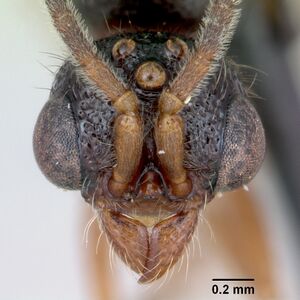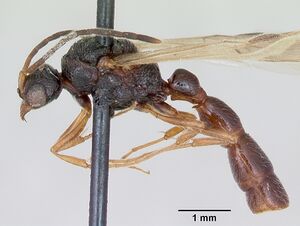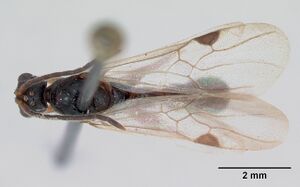Eusphinctus furcatus
| Eusphinctus furcatus | |
|---|---|

| |
| Scientific classification | |
| Kingdom: | Animalia |
| Phylum: | Arthropoda |
| Class: | Insecta |
| Order: | Hymenoptera |
| Family: | Formicidae |
| Subfamily: | Dorylinae |
| Genus: | Eusphinctus |
| Species: | E. furcatus |
| Binomial name | |
| Eusphinctus furcatus Emery, 1893 | |
In Thailand this species has been collected in evergreen forests (Jaitrong et al., 2016).
Identification
Jaitrong et al. (2016) - Eusphinctus furcatus is similar to Eusphinctus taylori in general appearance as they share the pygidial apex deeply notched (as seen from above), 11-segmented antenna, reddish brown body and swollen mesosoma. However, E. furcatus is easily separated from E. taylori by the following conditions: body larger (WL 1.68-1.78 mm in E. furcatus while WL 1.27 mm in E. taylori); petiole longer than broad (broader than long in E. taylori); body color darker (deep reddish brown in E. furcatus while light reddish brown in E. taylori).
- Larger species (WL 1.68-1.78 mm); body deep reddish brown; petiolar node longer than broad (India, Myanmar, and Thailand) . . . . . Eusphinctus furcatus
- Smaller species (WL 1.27 mm); body light reddish brown; petiolar node broader than long (India) . . . . . Eusphinctus taylori
Distribution
Latitudinal Distribution Pattern
Latitudinal Range: 17.719455° to 17.719455°.
| North Temperate |
North Subtropical |
Tropical | South Subtropical |
South Temperate |
- Source: AntMaps
Distribution based on Regional Taxon Lists
Oriental Region: India, Myanmar (type locality), Thailand.
Distribution based on AntMaps
Distribution based on AntWeb specimens
Check data from AntWeb
Countries Occupied
| Number of countries occupied by this species based on AntWiki Regional Taxon Lists. In general, fewer countries occupied indicates a narrower range, while more countries indicates a more widespread species. |

|
Estimated Abundance
| Relative abundance based on number of AntMaps records per species (this species within the purple bar). Fewer records (to the left) indicates a less abundant/encountered species while more records (to the right) indicates more abundant/encountered species. |

|
Biology
A. B. Soans and W. L. Brown collected two colonies of E. furcatus in Kottiyoor, Kerala, India. One was located in leaf litter near a rotting log and the other one was found under a stone in a shaded creek bottom. There were about 50 workers in each of the observed nests, and one colony contained two ergatoid gynes (Brown 1975).
Castes
Male
Images from AntWeb
    
| |
| Male (alate). Specimen code casent0173057. Photographer April Nobile, uploaded by California Academy of Sciences. | Owned by MCZ, Cambridge, MA, USA. |
Nomenclature
The following information is derived from Barry Bolton's Online Catalogue of the Ants of the World.
- furcatus. Eusphinctus furcatus Emery, 1893a: cclxxv (w.) MYANMAR.
- Type-material: syntype workers (number not stated).
- Type-locality: Myanmar (“Birmanie”): Palon, Pegu, viii.-ix.1887 (L. Fea).
- [Note: type-locality details from Emery, 1895k: 457, and Jaitrong, Wiwatwitaya & Sakchoowong, 2016: 4.]
- Type-depository: MSNG.
- [Also described as new by Emery, 1895k: 457.]
- Brown, 1975: 75 (ergatoid q.m.).
- Combination in Sphinctomyrmex (Eusphinctus): Emery, 1895k: 457;
- combination in Eusphinctus: Borowiec, M.L. 2016: 144.
- Status as species: Forel, 1900d: 328; Bingham, 1903: 25; Emery, 1911d: 7; Chapman & Capco, 1951: 21; Brown, 1975: 33, 75; Bolton, 1995b: 392; Bharti, Guénard, et al. 2016: 22; Jaitrong, Wiwatwitaya & Sakchoowong, 2016: 4 (redescription).
- Distribution: India, Myanmar, Thailand.
Unless otherwise noted the text for the remainder of this section is reported from the publication that includes the original description.
Description
Worker
Jaitrong et al. (2016) - Non-type worker (n = 6): TL 6.85-6.90 mm, HL 1.12-1.16 mm, HW 1.02-1.09 mm, SL 0.61-0.63 mm, EL 0.03-0.05 mm, WL 1.68-1.78 mm, PL 0.61-0.63 mm, PW 0.58-0.63 mm, CI 91-94, SI 58-61, OI 3-5.
Head in full-face view almost as long as broad, subrectangular, slightly broader posteriorly with side convex and posterior margin feebly concave; posterior corners of head bluntly angular; occipital margin bearing a narrow collar. Eye present, located in a foveola at middle of lateral face of head. Antenna 11-segmented; antennal scape relatively short, reaching midlength of head; II-VI each shorter than broad; XI slightly longer than VII+VIII+IX+X. Frontal carina short, extending 1/3 of head length, fused at posteriormost portion to form a single carina; parafrontal ridge extending posteriorly less than 1/3 of head length. Clypeus narrowly inserted between frontal carinae; median portion of clypeus with a distinct tubercle, anterior clypeal margin strongly concave. Mandible subtriangular, with basal margin rounding into masticatory margin; the latter apparently edentate.
Mesosoma stout and swollen, in profile with almost flat dorsal outline; promesonotal suture and metanotal groove obliterated; mesopleuron clearly demarcated from promesonotum by a deep groove and from metapleuron and lateral face of propodeum by a carina; propodeal junction obtusely angulated; declivity of propodeum shallowly concave, and encircled with a distinct rim.
Petiole in profile rectangular and sessile, clearly longer than broad, its dorsal outline straight, anterior and posterior faces vertical; subpetiolar process well developed, subtriangular, its apex truncate and directed downward, anterior margin convex, while posterior margin concave.
Gaster elongate, gastral segments I and II clearly separated by distinct constrictions, segments III, IV, and V separated from each other by deeply impressed, short constrictions; in dorsal view, gastral segment I (abdominal segment III) slightly narrower than gastral segment II, as broad as segment III, and broader than segment IV; segment III larger than IV in width and length; dorsum of pygidium shallowly concave with a row of spines laterally, pygidial apex deeply notched as seen from above.
Head with dense foveolae, foveolar intervals broad, smooth and shiny; antennal scrobe finely superficially reticulate but shiny; dorsum of mesosoma largely smooth and shiny with sparse, very shallow foveolae; lateral faces of pronotum, mesopleuron, metapleuron and propodeum with dense foveolae, foveolar intervals superficially shagreened but shiny; lateral face of petiole reticulate; each gastral segment with generally smooth and shiny.
Pilosity comparatively sparse; dorsum and lateral face of head with sparse standing hairs mixed with sparse short decumbent hairs; dorsa of mesosoma, petiole, gaster with sparse standing hairs; pygidium and hypopygium with dense longer hairs.
Body entirely deep reddish brown.
Bingham (1903): Dark reddish or ferruginous brown, the legs slightly paler, pilosity reddish, fairly abundant and stiff; head, thorax and abdomen with large, coarse, irregularly scattered punctures. Head rectangular, longer than broad, as broad posteriorly as in front; mandibles subtriangular, robust, the masticatory margin obscurely dentate, the base above striate; clypeus transverse, very narrow, raised in the middle and extending back between the antennal carinte, which are very short, prominent and close together, curving anteriorly outwards along the posterior margin of the clypeus; antennae very thick and short; occiput slightly and widely emarginate. Thorax elongate, rectangular, compressed, the sides parallel, the apex obliquely truncate and carinate around the margin of its posterior face. Pedicel and abdomen with the characters as given in the genus, the last segment flat above, bifurcate at apex.
Type Material
Jaitrong et al. (2016) – syntypes, workers from Myanmar, Palon, Pegu, VIII.IX 1887, L. Fea leg.
References
- Borowiec, M.L. 2016. Generic revision of the ant subfamily Dorylinae (Hymenoptera, Formicidae). ZooKeys 608: 1-280 (doi:10.3897/zookeys.608.9427).
- Bingham, C. T. 1903. The fauna of British India, including Ceylon and Burma. Hymenoptera, Vol. II. Ants and Cuckoo-wasps. London: Taylor and Francis, 506 pp. (page 25, see also)
- Brown, W. L., Jr. 1975. Contributions toward a reclassification of the Formicidae. V. Ponerinae, tribes Platythyreini, Cerapachyini, Cylindromyrmecini, Acanthostichini, and Aenictogitini. Search Agric. (Ithaca N. Y.) 5(1 1: 1-115 (page 75, see also)
- Emery, C. 1893a [1892]. [Untitled. Introduced by: "M. C. Emery, de Bologne, envoie les diagnoses de cinq nouveaux genres de Formicides".]. Bull. Bimens. Soc. Entomol. Fr. 1892:cclxxv-cclxxvii. (page cclxxv, worker described)
- Emery, C. 1895m. Viaggio di Leonardo Fea in Birmania e regioni vicine. LXIII. Formiche di Birmania del Tenasserim e dei Monti Carin raccolte da L. Fea. Parte II. Ann. Mus. Civ. Stor. Nat. 34[=(2(14): 450-483 (page 457, also described as new)
- Emery, C. 1895m. Viaggio di Leonardo Fea in Birmania e regioni vicine. LXIII. Formiche di Birmania del Tenasserim e dei Monti Carin raccolte da L. Fea. Parte II. Ann. Mus. Civ. Stor. Nat. 34[=(2(14): 450-483 (page 457, Combination in Sphinctomyrmex (Eusphinctus))
- Jaitrong, W., Wiwatwitaya, D. & Sakchoowong, W. 2016. Review of the Thai species of the genus Sphinctomyrmex Mayr, 1866 (Hymenoptera: Formicidae, Dorylinae), with description of a new species. Far Eastern Entomologist. 305:1-9.
- Khachonpisitsak, S., Yamane, S., Sriwichai, P., Jaitrong, W. 2020. An updated checklist of the ants of Thailand (Hymenoptera, Formicidae). ZooKeys 998, 1–182 (doi:10.3897/zookeys.998.54902).
References based on Global Ant Biodiversity Informatics
- Bharti H., B. Guénard, M. Bharti, & E. P. Economo. 2015. An updated checklist of the ants (Hymenoptera: Formicidae) of India with their specific distributions in Indian states. Zookeys
- Brown W. L., Jr. 1975. Contributions toward a reclassification of the Formicidae. V. Ponerinae, tribes Platythyreini, Cerapachyini, Cylindromyrmecini, Acanthostichini, and Aenictogitini. Search Agric. (Ithaca N. Y.) 5(1): 1-115.
- Chapman, J. W., and Capco, S. R. 1951. Check list of the ants (Hymenoptera: Formicidae) of Asia. Monogr. Inst. Sci. Technol. Manila 1: 1-327
- Chapman, J.W. and S.R. Capco. 1951. Check list of the ants (Hymenoptera: Formicidae) of Asia. Monographs of the Institute of Science and Technology (Manila) 1: 1- 327
- Emery C. 1893. [Untitled. Introduced by: "M. C. Emery, de Bologne, envoie les diagnoses de cinq nouveaux genres de Formicides".]. Bulletin Bimensuel de la Société Entomologique de France 1892: cclxxv-cclxxvii.
- Emery C. 1911. Hymenoptera. Fam. Formicidae. Subfam. Ponerinae. Genera Insectorum 118: 1-125.
- Forel A. 1900. Les Formicides de l'Empire des Indes et de Ceylan. Part VII. J. Bombay Nat. Hist. Soc. 13: 303-332.
- Jaitrong W., D. Wiwatwitaya, and W. Sakchoowong. 2016. Review of the Thai species of the genus Sphinctomyrmex Mayr, 1866 (Hymenoptera: Formicidae, Dorylinae), with description of a new species. Far Eastern Entomologist 305: 1-9.

